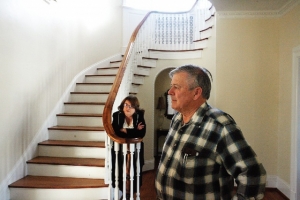DGDC officials say Neighborhood Plan coming along
By Kenneth Fine
Published in News on November 8, 2009 1:50 AM

News-Argus/MITCH LOEBER
Glenn Barwick and his wife, Judith McMillen, stand in the foyer of the home they are renovating on George Street. The house was built in the 1920s.
When Glenn Barwick and his wife, Judith McMillen, purchased the old Borden family home on George Street, they knew what they were getting themselves into -- years of renovation and restoration, tens of thousands of dollars.
"It was a boarding house of ill repute," Ms. McMillen said.
But walking the halls of the 7,000-square-foot estate, they saw seemingly endless possibilities beyond the sections of missing ceiling and holes in the wall.
And the city government seemed to be committed to restoring the neighborhood that surrounded it, they said -- less than a mile from where the house stands, a new Paramount Theater and City Hall had been constructed, and the City of Goldsboro Comprehensive Historic Neighborhood Revitalization Plan had been adopted.
But in the end, what really sold the husband and wife was their passion for historic properties and their vision of what -- with the right amount of work -- could be.
"It was a decision made with the heart," Ms. McMillen said.
The neighborhood plan, as it is informally known, came to life in February 2006, when members of the City Council approved the concept and established a $100,000 revolving fund for the purpose of acquiring properties in target neighborhoods -- the North James Street/North George Street neighborhood, South William Street/South John Street neighborhood and the area surrounding Union Station.
Downtown Goldsboro Development Corp. executive director Julie Thompson said the three areas were chosen based on the number of dilapidated homes located within them.
"At the time when we surveyed all the properties downtown that were threatened with demolition and condemnation, those three areas had the highest density of those kind of houses," Mrs. Thompson said.
Barwick remembers a time before many of the properties located in those neighborhoods were characterized as run down.
"Back in the early 1960s, these were great, great neighborhoods. They were vibrant," he said. "I remember when the millionaires lived in these neighborhoods."
Members of the city government remembered, too, and so the board continued to support the DGDC, as the non-profit organization, through a partnership with Preservation North Carolina, made its first property purchase in June 2006. Since that time, 39 homes and commercial buildings have been added to that list.
More than a dozen of those properties have been sold to date, and several, like the old Borden home, are still in the process of being revitalized.
"In the neighborhood plan, when we pitched it to the council, we said even if we just turn 16, because there were 16 homes that were immediately threatened at the time that we really wanted to save, we said, 'Let's just take those 16.' If you just get those homes sold ... that's a huge increase in that tax base," Mrs. Thompson said.
But more importantly, it would bring affluent families back to a downtown that, over the years, has been associated with crime and deteriorating rental property.
"My goal is to get these three neighborhoods back to at least 50 percent owner-occupied," Mrs. Thompson said. "Then, I think the market could take care of itself."
That reality, she added, is not too far off in the distance.
In fact, she expects to have the remaining 25 properties currently being marketed by the DGDC to sell within the next five years, "give or take."
"From an investment standpoint, it's a no-brainer really, if you like historic homes and you like the character and everything that comes along with it," Mrs. Thompson said. "Now is the time to get in on it. The value of your investment will only increase over the next few years."
She cited city projects currently in progress -- the revitalization of Union Station and the Downtown Master Plan -- to back that claim.
Barwick agrees.
"When I heard they were going to move forward with the Union Station project, that's what made me confident that this area is coming back," he said. "I think this whole neighborhood is going to get the shot in the arm it needs."
So does Mrs. Thompson, thanks, in part, to the "new philosophy" at City Hall.
"We are continually scoping out properties that we need to save," she said. "And now, unlike in the past, (Chief Building Inspector Ed Cianfarra) will come to me any time we have a house in one of these neighborhoods ... he will contact our office and say, 'Just so you know, we sent them a first phase condemnation letter.'"
*
Barwick remembers his second date with his wife, when they drove past the 7,000-square-foot house they are now working tirelessly to restore.
"He said I told him, 'That's my dream house,'" Ms. McMillen said. "Now I don't remember saying it, but I have just always loved this house."
And now that they live there, the couple, like other neighborhood plan advocates, are simply waiting for others to make the same investment -- not just in a home, but in the spirit of bringing downtown Goldsboro back to where it once was.
"By the end of the 1980s, there was not much left, but it's coming back," Barwick said. "And I think you might really start seeing some more things happen around here once people realize that."
His wife agreed.
"People's perception of downtown is based on the way it was 20 years ago," she said. "But it's really starting to change."
